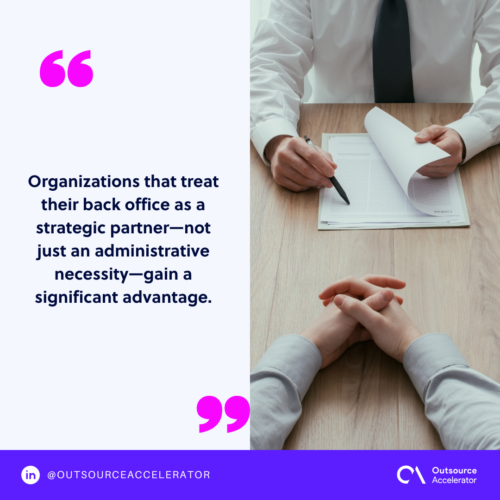Why back office roles are crucial to business continuity

In every business, there’s a quiet force that keeps everything moving smoothly—the back office.
While front-line teams handle customer interactions and visible outcomes, back office roles ensure the gears of an organization never stop turning. They handle payroll, process data, reconcile accounts, manage IT systems, and maintain compliance.
These unsung professionals are also at the heart of business continuity.
When unexpected disruptions occur (whether from global crises, cybersecurity threats, or internal system failures), it’s the back office that ensures the company stays operational. They ensure employees get paid, and critical information remains accessible.
Without a resilient back office, continuity plans are merely theory. This article explains why you should ensure your back office system is strong enough for good business.
Back office roles and their impact
Back office roles are often underestimated, but they’re foundational to a company’s structure. These positions include accountants, HR administrators, IT support specialists, data analysts, and operations coordinators.
They may not engage directly with customers, yet their work affects nearly every business outcome.
A well-coordinated back office ensures smooth cash flow, accurate reporting, and seamless communication between departments.

For example, accountants guarantee financial transparency, HR keeps the workforce aligned and supported. Meanwhile, IT maintains the infrastructure that allows everyone else to do their jobs efficiently.
Think of the back office as the circulatory system of a business. It may not be visible, but it delivers the oxygen that keeps the organization alive.
According to Credence Research, the worldwide market for back office outsourcing reached a valuation of $264.75 billion in 2024. This market is expected to nearly double, with projections suggesting it will grow to $487.00 billion by 2032, expanding at a CAGR of approximately 7.37%.
This indicates that investment in back office functions is growing strongly, reflecting their increasing strategic importance to operations and continuity.
When these functions run efficiently, front-end teams can focus on innovation, service, and growth—secure in the knowledge that the foundation beneath them is solid.
The connection between back office roles and business continuity
When people discuss business continuity, they often imagine disaster recovery plans or emergency communication protocols. Yet the true backbone of continuity lies in everyday operational stability—precisely what back office roles provide.
1. Operational stability during disruptions
Back office teams ensure that no matter what happens, the essentials continue. They maintain payroll even during crises, keep financial data current, and ensure IT systems remain secure and functional.
This operational discipline allows leadership to focus on strategy rather than scrambling to restore order.
2. Compliance and risk management
Finance and administrative roles are the first line of defense against compliance risks. They maintain records, ensure legal obligations are met, and identify anomalies before they escalate into serious problems.
During business disruptions, their vigilance helps avoid fines, data breaches, or reputational damage—core elements of business continuity.
3. Data security and systems reliability
IT and data management roles are central to keeping business systems running. From cloud backups to cybersecurity monitoring, they ensure critical information remains safe and accessible.
When every minute of downtime costs thousands, a dependable IT back office isn’t a luxury; it’s the only way to stay in business.
In short, back office roles transform business continuity from a reactive plan into a proactive strength. They ensure that when challenges arise, the company doesn’t just survive—it adapts.
Strengthening business continuity through back office optimization
Optimizing the back office isn’t just about cutting costs—it’s about building resilience. Modern tools and strategies can turn these traditional support functions into engines of innovation and agility.
1. Process automation and digital tools
Automation has revolutionized the way back offices operate. Tasks like invoice processing, data entry, and reporting can now be handled by intelligent systems, reducing errors and freeing employees to focus on strategic work.
Automation not only boosts efficiency but also supports business continuity by minimizing dependency on manual processes that can falter during disruptions.
2. Building resilient and skilled teams
Cross-training and upskilling back office staff are equally vital. When employees understand multiple systems or functions, operations can continue even when someone is unavailable or when workloads spike unexpectedly.
A flexible back office team helps businesses pivot quickly, an essential capability in today’s unpredictable environment.
3. Integrating back office strategy with continuity planning
Organizations that treat their back office as a strategic partner—not just an administrative necessity—gain a significant advantage. Including these teams in continuity planning ensures that recovery procedures align with real operational workflows.
This holistic approach makes continuity plans more realistic, actionable, and effective.

Partnering for reliable back office support with Sourcefit
Building a resilient back office takes time, expertise, and the right talent mix. That’s where Sourcefit can help.
Sourcefit specializes in creating flexible, high-performance back office teams tailored to your organization’s needs. Whether you require finance and accounting professionals, administrative specialists, or IT support experts, Sourcefit delivers dedicated talent that integrates seamlessly with your existing operations.
By partnering with Sourcefit, businesses can strengthen their business continuity posture through reliable staffing, process optimization, and technology-backed support. The result is an operational core that stays steady, even in times of uncertainty.
Empower your organization with the back office strength to keep operations running—no matter what.
Learn how Sourcefit can help you build resilience and ensure lasting business continuity.







 Independent
Independent




